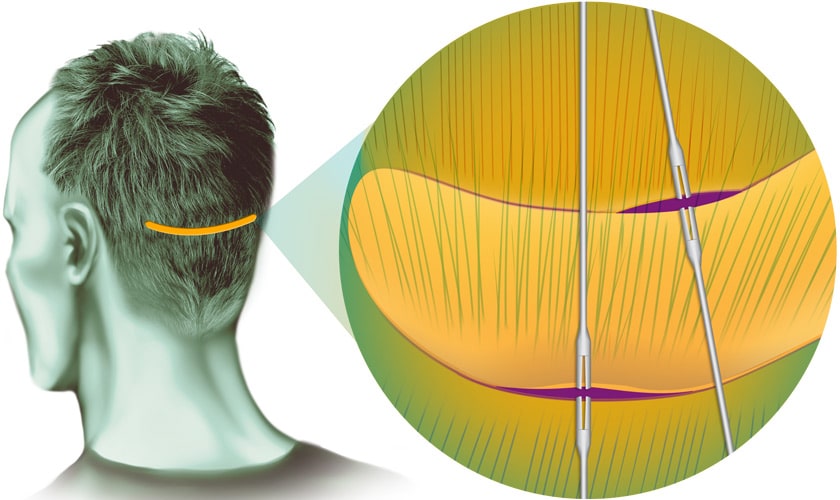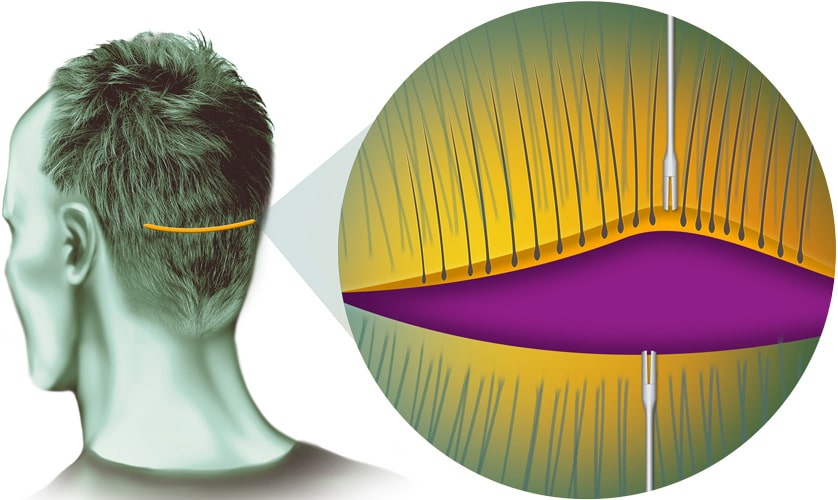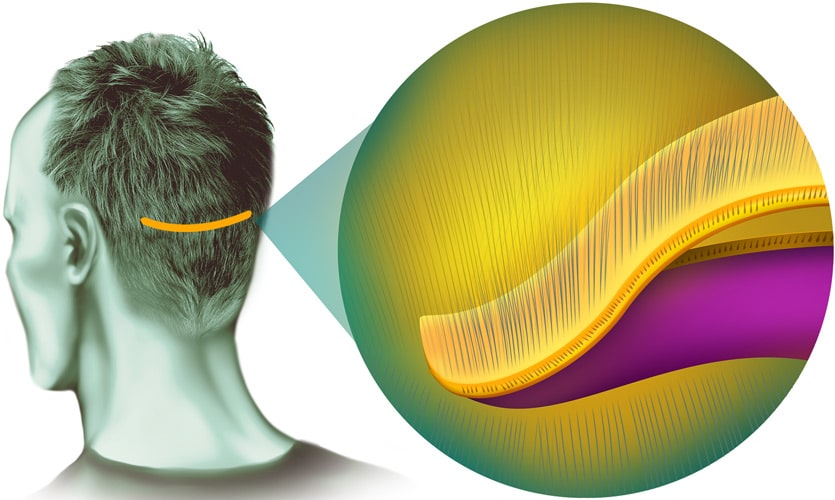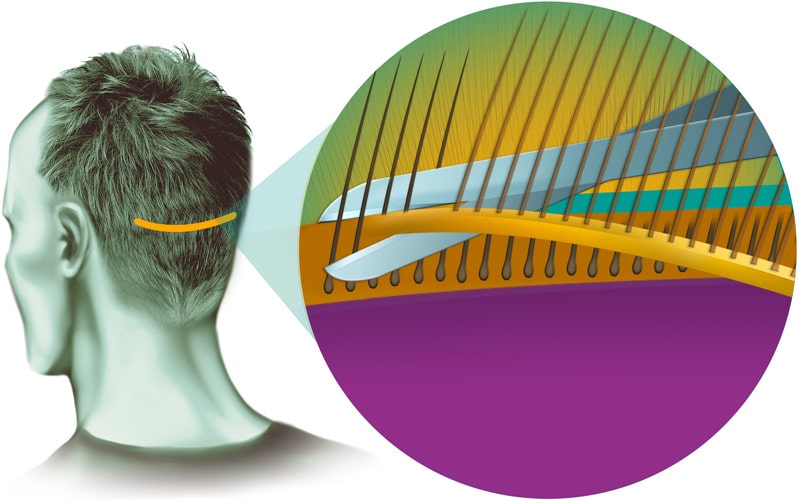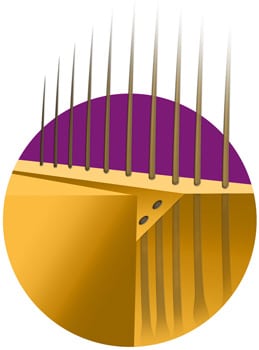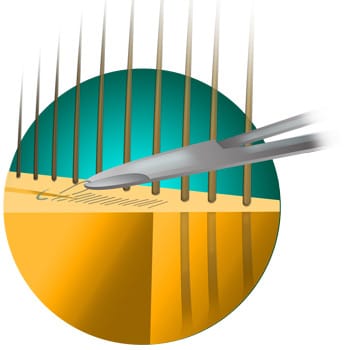Presently there are two different techniques to take the hair from the back and sides of the head and transplant it in the concerned area of thinning or balding.
The following are the techniques.
- Follicular Unit Extraction FUE
- Long Hair Technique
Follicular unit extraction ( FUE )
The donor area is marked, and a vertical line is drawn in front of the ear, behind this vertical line, in the parietal and occipital area, 2cm of healthy hair are left in the upper and the lower margins. The area within the above-mentioned margins is considered the Donor area for FUE.
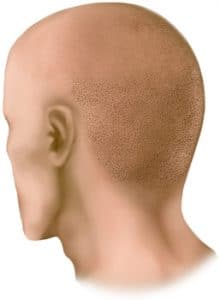
A shaved donor area is needed for Follicular unit extractions. The donor area can be partially or completely shaved. If the Donor area is completely shaved, 2000-3000 follicular units can be extracted in one-day surgery. If the donor area is partially shaved in a way that top hair cover the shaved areas, in this situation only 1000-1500 follicular units can be extracted. Special micro punches are used to punch out the follicular units. Motorized micro punches are faster.
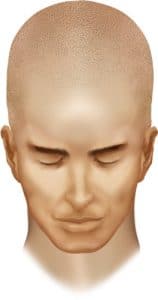 Different approaches for follicular extraction
Different approaches for follicular extraction
- Manual micro punches technique
- Motorized micro punches technique
- Motorized Suction punches technique
- Robotic punch technique
For extraction few Doctors prefer using manual punches and few prefer motorized punches. There is also a suction-based extraction machine, hair technician mostly operate this machine to save time for the hair transplant surgeon. There is a robotic machine available for follicular unit extraction as well.
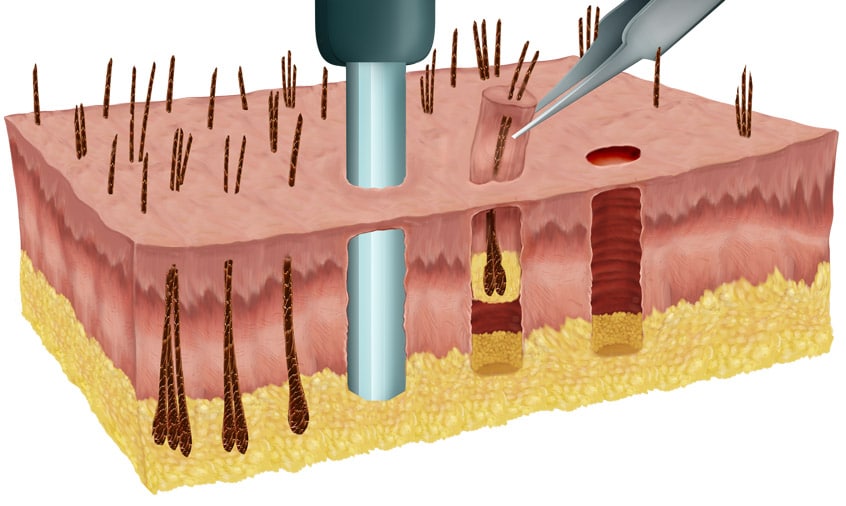
The goal in using any of the above-mentioned techniques is minimum damage during extraction.
Advantages of FUE
- Once the donor area heals, there is no noticeable scarring in the donor area.
- The client has the flexibility to wear the hair extremely short or even shave off the hair without the fear of any visible scarring in the donor area.
- If the donor area is very tight, FUE technique can be used.
- FUE could be combined with the long hair technique to maximize the total number of follicular units transplanted in one surgery. In the long hair Technique, there is a maximum safe limit of taking out follicular units, which varies individually from an average 2000 to 6000 follicular units. For example, 5000 follicular units are obtained by long hair technique; still average 500 to 1000 follicular units can be extracted by FUE technique without adding any tension to the donor area.
- FUE can be repeated after one month, long hair technique can not be repeated before 6 months.
Disadvantages of FUE
- The micro punch is moved down over the follicular unit to cut free the tissue around the follicular unit, so the follicular unit free to be extracted out with fine forceps. Due to blind cutting to make the follicular units free to be extracted, the punch can damage an average 5% of the follicular units.
- The punching and extracting out process in FUE can traumatize the follicular units which can lead to decreased survival.
- There is a limitation of an average 2000 to 3000 follicular units extraction in one surgery.
- If the head is shaved to extract maximum follicular units, extraction sites are visible for average of 10 days.
- In transplanted area surgery is noticeable for an average of 10-15 days.
- There is Temporary numbness feeling in the Donor and transplanted area.
Long Hair Technique
A horizontal line is marked In the middle of the parietal and occipital area, leaving an equal amount of hair above and below the line. Depending on the individual flexibility and laxity of the Scalp, this marked line is stretched on an average from 1cm to 2.5 cm. An incision of an average 0.5 mm deep in the direction of hair is made at the upper and lower borders of the marked donor area. Skin hooks are used to open up the upper and lower incision. The incision margins are stretched by skin hooks, the follicular units in the incised area get separated. As this technique offers direct visualization, there is no damage to the hair. The extracted hairs are intact and not traumatized.
Once the Donor hair strip is out, there is an average 1-2 cm gap depending on the width of the extracted strip and upper and lower skin margins. In the upper skin margin, an average 1 mm wide and 3/4 mm deep tissue is shaved (Trichophytic Technique). In the tissue gap, A Cell growth factor sheath is laid for better healing. The upper and lower edges are fine stitched together. Hair grows out in the scar line because of Trichophytic technique, most of the time scar line becomes undetectable due to trichophytic closure.
The follicular units are separated under the microscopes. The average hair damage in strip removal and in the preparation of follicular units under the microscope is 0 to 0.4 % of the total number of hair.
Alternative Approaches For Long Hair Technique
Most of the doctors Trim the marked donor area. The incision is made up to the full follicular depth by single or multiple blades, A Cell is not used. Full follicular depth incision leads to higher hair damage. The use of multiple blades further increases the risk of higher follicular damage.
Advantages of Long Hair Technique
- There is damage of 0 – 0.4% in comparison with FUE damage of 5% in follicular units preparation.
- These follicular units are intact and non traumatized with almost 100% survival.
- An average 4000 follicular units can be performed in one surgery. If the flexibility and density are good, an average of 6000 follicular units can be performed in one surgery.
- Long hair Technique could be combined with FUE to increase the number of follicular units transplanted in one surgery.
- Higher follicular unit numbers and near 100% survival help to achieve the client’s goals in one surgery.
- The donor hair is not shaved or trimmed, stitches are covered by one’s own hair.
- The same length transplanted hair on the front keep the surgery sites unnoticeable.
- The long hair transplanted in the hairline give the preview of the future hairline and outcome. Follicular units can be readjusted if needed during the surgery depending on the initial look.
- Trichophytic fine stitch closure and use of A Cell sheath, leads to very fine scar and sometimes unnoticeable scar. The area is covered by one’s own hair.
Disadvantages of Long Hair Technique
- If a person trims the hair extremely short like No 1 Machine or shave off the hair, there are chances of noticeability of stitches mark or fine scar in the donor area.
- Temporary numbness feeling in the donor area.
- Increase chances of shock hair loss in the transplanted area. Hair lost due to shock grows back along the transplanted hair.
Planting The Follicular Units In FUE And Long Hair Technique
Recipient Sites
In creating the Recipient sites, an important consideration is given to four things.
- Size
- Angle
- Direction
- Types
Size
Follicular units diameter is the main determining factor for the recipient site size.
Recipient sites are made with custom-cut micro blades in all three techniques. These micro blades are custom cut according to the size of the follicular units. For single hair follicular unit, the average size of the micro blade depending on hair diameter is 0.6 to 0.7 mm. For two hair follicular unit average size of the micro blade is 0.7-0.8 mm. For three to four hair follicular units, the average size of the blade is 0.8-0.9 mm. Needles and special blades also can be used for creating the sites.
Angle
Hair exit the scalp at a different angle in a different part of the scalp. In the hairline area, hair exit the scalp at an average 20 degree, as moving back toward the mid-scalp angle gradually increases from 20 to 60 degree , moving further back angle gradually start decreasing in the crown area. In the occipital area, the hair exit the scalp at an average 20 degree. In the parietal area the hair exit the scalp at an average 20 degree angle. In the temple area the hair angle of exit is an average 10 degree.
Direction
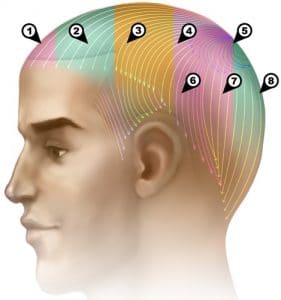
In creating the recipient sites, important consideration is given to the direction as well. Sites are made according to the natural direction in the bald area. In the hairline ,near the frontal midpoint , hair are directed forward , as moving from the frontal mid point toward the fronto temporal angle , hair gradually start directing sideways . Moving back in the mid scalp, the hair direction is same, but the angle change from 20 degree in hairline to 60 degree in the posterior part of the mid scalp. In the temple area, hair are directed down and backward. In the parietal area and occipital areas, hair are directed downward. In the crown or vertex area hair are in whorl pattern.
When creating sites in the thinning area, direction of the sites and angle of exit from the scalp is matched to the existing hair.
Types
There are two types of sites
- Perpendicular
- Parallel
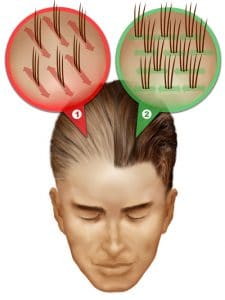
Perpendicular
With perpendicular site creation the width throughout the length of the site stays same at any angle. When multiple hair follicular units are transplanted in perpendicular sites, Hair are lined side by side, it creates better density.
Parallel
With parallel site, the width of the site at skin level is an average 50% more. When multiple hair follicular units are transplanted in parallel sites, hair are lined behind each other, creating a less dense look in comparison to perpendicular sites.
Advantage of perpendicular sites
- In the hair line the average desired angle of hair exit from skin is 20 degree. As the width of site throughout it length is same, it allows to achieve desired angle.
- The the superficial trauma to the skin on an average is 50% less than the parallel sites.
- As the width of site throughout it length is same, the follicular units has equal pressure through out the length of the site, leads to better healing.
- In the area behind the hair line, two and three hair follicular units is used, hair is lined side by side, and it creates a look of better density.
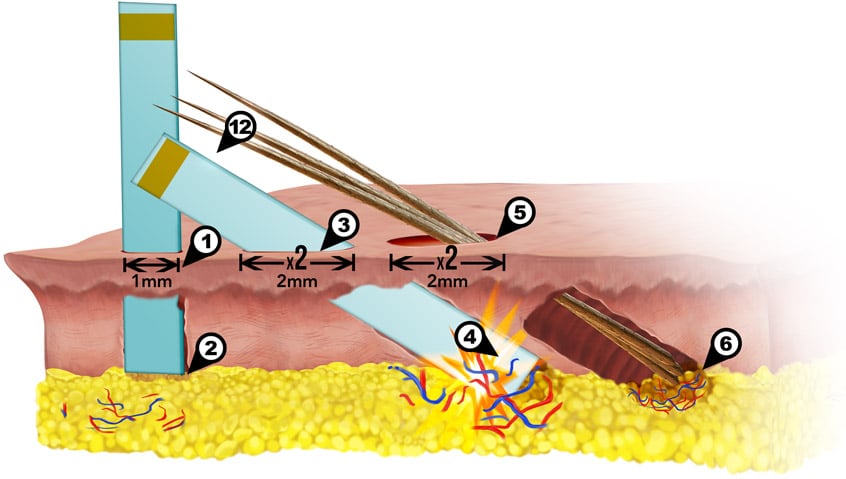
Parallel sites
- The width of the site throughout the entire length is same only if the sites are made at 90 degree angle, as the angle decrease the width of the site at skin level increases. In the hair line and temple area where the desired angle is 20 degree and 10 degree respectively, the width of the site at skin level is an average 50% more, it leads to increase superficial trauma , delay in healing and inability to maintain the desired angle .
- As the width of the site is more at skin level, the pressure on the follicular units decreases toward the surface. The uneven pressure on the follicular units can lead to difficulties in placing.
- As the width is more at skin level, especially in hair line and temple area where the desired angle is 20 degree and 10 degree respectively, the follicular unit has more room to move so the desired angle cannot be achieved.
- Behind the hair line where two and three hair follicular units are used, the hair are lined behind each other, create a less dense look in comparison to perpendicular sites.
FUE
The extracted follicular units are already trimmed, before planting the follicular units, they are treated with A Cell Growth factor solution. The survival of follicular units are 90 – 100 %.
The transplanted area is noticeable for 10 -15 days.
Long Hair Technique
The follicular units prepared under microscopes are healthy and strong . Survival of these follicular units are 100%. Use of A Cell is optional. These follicular units are untrimmed, when planted, keep the surgery sites unnoticeable and provide the preview of final outcome.
Alternate Approach To Long Hair Technique
The follicular units prepared under microscopes are healthy and strong. Survival of these follicular units are 100%. Use of A Cell is optional. These follicular units are trimmed. The transplanted area is noticeable for 10-15 days.
HOW TO CHOOSE THE RIGHT SURGERY FOR YOURSELF
FUE
Reasons to Choose FUE
- If the life style of the client is to wear the hair very short like number 1 machine or keeping the hair shaved most of the time, FUE is better choice of not having any visible scaring in the donor area.
- If client does not want to have incision and stitches, FUE can be chosen.
Long Hair Technique
Reasons to Choose the Long Hair Technique
- Only technique which allows to go back to work next day without any surgical sites notice ability.
- Long hair technique offers more follicular units in one surgery which results in major change in appearance.
- Survival of transplanted hair is better than other techniques.
- Long hair technique provides reasonably good density in one procedure.
- Hair damage during the surgery is minimum 0-0.4 % with long hair technique.
- With Long hair technique there is a possibility of fine scar in the donor area which is covered by the hair. If the lifestyle is to wear the hair half an inch or more in length most of the time, long hair technique is the absolute best choice.

